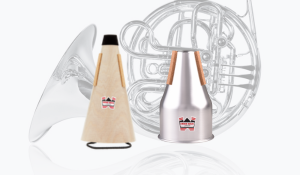The Straight Goods on French Horn Wooden Straight Mutes

 With horn players, what we put in the bell is very important. It starts at the very beginning with how to hold the instrument. The right hand position can make or break things like tuning, tone quality, projection, how easily the instrument plays, and even the range.
With horn players, what we put in the bell is very important. It starts at the very beginning with how to hold the instrument. The right hand position can make or break things like tuning, tone quality, projection, how easily the instrument plays, and even the range.
While muted passages become more common as players advance, the need for a mute in band or orchestra can happen after only a couple years. As with the position of the hand, the mute choice makes all the difference in how the horn plays.
But I’m getting ahead of myself. First, why do we use mutes? There are different mutes for different sounds and purposes, but in general they are used to create a different quality of sound and/or to reduce the volume. They are used as indicated by the composer in specific passages of music. The player will see words like sordino (Italian), dämpfer (German), sordine (French), or of course ‘mute’ on their music to indicate that a mute is to be used.
Get our newest tips, updates, videos, clinics, community events, and more by joining Denis Wick Tips Blog
The most common type of mute is the straight mute. It is shaped like a cone with a hole at the point. Once inserted they are held with cork strips that stick against the metal inside the bell. Though there are various materials used for mutes, wood is common for professional quality designs of superior sound quality. They are made in varying types, thicknesses, and with different finishes. Some mutes have a tab inside that can be slid in and out to tune the mute. This is important because bell shape and size can vary, which changes the tuning because of where the mute fits inside the bell.
How easily the horn sounds with a mute depends on the mass involved. While a heavier, thicker mute will produce a dark and soft sound, it will limit how quickly a note can respond and will make it more difficult to play notes in the lower register.
There are many mute brands available. These vary with respect to tone, range, and response. Unfortunately, the ones of acceptable quality usually range in price from $150 to $300.
The Denis Wick Wooden Straight Mute is made of a thin birch that creates a warm sound and will easily play soft. It does not have a heavy lacquer, so it responds quickly. It works well over the entire range of the instrument and is tunable. Players looking for an effortless response and focus in the low range will especially like this mute. It’s also affordable at around $130.
So whether you’re upgrading, looking for your very first mute, or looking to outfit an entire horn section, consider the wooden straight mute. Just remember, be careful what you put in your bell!

Find all our Denis Wick resources in one spot on the Denis Wick app. Download to view videos, clinics, educator resources, podcasts, product information & more!




